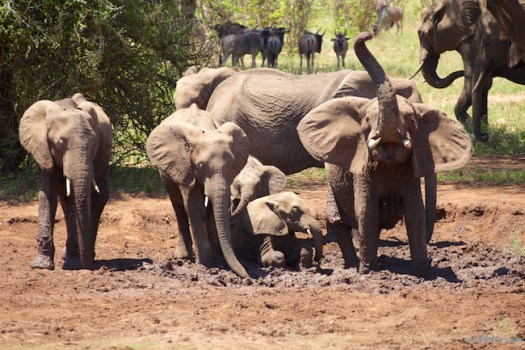Our team of sled-dogs whisks us deeper into the Lapland tundra, where mountains drop off into the fjords and wild reindeer roam. We are in Oteren, Norway with Lyngsfjord Adventure, an outfitter that knows how to make the most of the Arctic Circle. We stayed here for two days to catch the Northern Lights, try our hand at dog sledding, soak up tribal Sami culture, and make memories we will never forget.

The Lyngsfjord team picked us up in the arctic capital of Tromsø with a few other guests, some coming to chase the aurora borealis, others to go snowmobiling and ice fishing for the night and those who wanted to pack in multiple adventures with an overnight stay at Camp Tamok. After a 75-minute drive deep into the wilderness, we arrived at camp and got suited up in Lyngsfjord’s insulated bodysuits, boots, and gloves to take on the Arctic.

Our first excursion was something we never thought was possible outside of Christmas stories…reindeer sledding! Reindeer are actually the oldest form of transportation in northern Scandinavia and an integral part of Sami culture. Our leader Roar Nyheim, a Sami tribesman who grew up in Lapland herding reindeer, gave us a brief safety speech, then said, “Sit back and enjoy the view!” Cuddled up in blankets, Mike and I gazed up at the star-filled sky and snow-capped mountains until we arrived at Roar’s favorite spot. He made a campfire and served us tea in record time, all while regaling us with stories of the traditional Sami life and legends.

We returned to camp and were ushered into a Lavvu-style tent for hearty stew and hot drinks. Guests swapped stories from their adventure of choice, then either headed back to Tromsø or got settled in for the evening. For those of us who stayed, we had an exciting night of Aurora-chasing ahead of us. This area of Norway is known for its clear skies and lack of light pollution so the Northern Lights are visible most nights from November to March. We stayed up well past midnight watching green and purple striations swirl between the shining stars.

For lodging, guests and groups can stay in the Wilderness Cabin or Traditional Sami Tent, but for couples, the most romantic choice is the Aurora Chalet. This wooden cabin perched above the riverbank is charming and toasty warm, but its best feature is the skylight–perfectly angled to watch the Northern Lights from bed!

Before our traditional Norwegian breakfast, we had a delightful sauna session. It warmed us to the core and loosened our muscles for the day of dog sledding ahead.

Mike and I got a quick mushing lesson, were assigned to our team of five huskies, then set off into the Vass Valley! We thought dog sledding would be difficult but Lyngsfjord’s huskies are so well trained, they just run and you break and lighten the load, as needed (by jogging behind them on the hills, so fun!). The important thing to know is that once the huskies start running, they don’t stop..so hang on!
To see what it’s like to drive a pack of huskies through the snow, watch this clip from our 15-kilometer ride through this Norwegian winter wonderland!

By our second day at Lyngsfjord Adventure, we’d figured out how Norwegians keep from getting cold in the Arctic… adrenaline! Insulated clothing helps, but mushing huskies, riding reindeer sleighs, and chasing the Northern Lights is the secret to feeling warm inside and out.
Anne and Mike Howard are creators of the around-the-world honeymoon blog HoneyTrek.com and Long Term Travel Coaches for anyone looking to travel the world safely, affordably and off the beaten path. You can follow @HoneyTrek on Facebook, Instagram, and Twitter.
Mike and Anne Howard left on their honeymoon in 2012 and have been traveling the world ever since. HoneyTrek.com chronicles their adventures across 7 continents, 44 countries, and counting! Their writing, photography, and the story of the “World’s Longest Honeymoon” can also be found on Condé Nast Traveler, BBC Travel, The Knot, Los Angeles Times, CBS, and dozens of other international publications. Connect with @HoneyTrek on Facebook, Instagram, and Twitter.
















